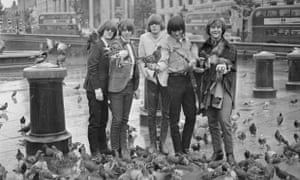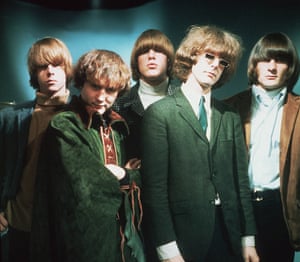The Byrds happened. Suddenly, with little enough warning for any of us. For me, it started a couple of days after I arrived in Hollywood in February, when a cameraman I had met on the Beatles’ tour sauntered into my then uncluttered office and dropped a couple of pictures casually on my desk. “There’s a group here you may like to look at,” he said. “They’re called the Byrds. They may be lousy for all I know.”
I had come to California to work as a press agent. I had two clients – both rock groups. One was Paul Revere & the Raiders, the other the Beau Brummels. All long-haired. So here was a third. Nothing was known about them. They hadn’t performed together in public as a group. They hadn’t released a record. They weren’t good looking. And they had no money at all. Very promising.
In this week’s Rock’s Backpages, to mark 50 years since the Byrds released Mr Tambourine Man, here’s a feature by the late, great Derek Taylor, originally published in Melody Maker on 17 July 1965
However, I called their manager and he came into the office. His name was Jim Dickson, a roly-poly man, prematurely bald, who had been an A&R man for folk singers. He had a kind smile and gentle eyes and he looked honest. Which is something in Hollywood. He too, was broke. But, he said the Byrds were pretty good and Columbia Records had recorded them with a number called Mr Tambourine Man. He had a copy of it and he played it to me. Bob Dylan, he explained, had written the song and had approved the Byrds’ version. I said, “I think it’s a hit.” And he said, “We think so too.” They were due to make their first public appearance for $10 each at Ciro’s, a large, unfashionable nightclub on Sunset Strip.
Difficulties
It was the haunt of Errol Flynn and Humphrey Bogart in their brawling prime, and of Van Johnson and Cary Grant and a thousand glamorous ghosts. So I went to see the Byrds. They had unimaginable mechanical difficulties – amplifier breakdown, inadequate microphones. Collectively, they had never faced an audience and they were shy, ill at ease and not at all a unit. Yet something was happening on stage. It was something over and above normal rock experience.
I offered to represent them for a few dollars a week just for the hell of it. But manager Dickson and his partner, Eddie Tickner, a slim cautious man who used to work for the US army audit department, said: “Stick around and keep smiling, but we can’t afford to pay anything yet.” I stuck around and stuck out and offered to take a percentage of the group’s income. Finally, Tickner and Dickson agreed and I was in.
Mr Tambourine Man was released in America in April. Radio Station KRLA in Los Angeles liked it and the city’s Beatlemaniac disc jockey, Dave Hull, decided to pick it as his Tip for a Hit.
I went into print in the station’s newspaper to forecast it as a nationwide No 1. Five weeks later, it had bounded in leaps of 30 places to the top of all the national charts – Cash Box, Billboard, Record World, plus hundreds of local lists. By the end of June, the Byrds were the pop music talking point of America.
They were featured on the front cover of all the trade newspapers. Their fan club members were numbered in thousands. And both sides of their second American release, All I Really Want to Do and I’ll Feel a Whole Lot Better, are, at this moment, climbing rapidly to replace Mr Tambourine Man at the top.
Packed
Abroad, Mr Tambourine Man was also one of the records of the year. It went into the Australian and Canadian top five, and after a rush-release in Britain it climbed into the coveted English charts.
The Byrds returned to Ciro’s, and for the first time in years packed the place. There were queues up and down Sunset Strip of desperate teenagers clamouring to get in.
The dancefloor was a madhouse. A hardcore of Byrd followers – wayward painters, disinherited sons and heirs, bearded sculptors, misty-eyed nymphs and assorted oddballs – suddenly taught Hollywood to dance again. This was no Shake, Watusi or Frog session. It was an exercise in “Byrdmania”. A frenetic extension of the talents of five quite exceptional pop musicians.
None of the Byrds is easy to get to know. In this – as in many other respects – they resemble the Beatles.
They are all intelligent, cool, acutely aware of the follies, extravagance and hypocrisy in show business. But because they had willingly abandoned their separate impoverished careers in the less remunerative branches of the industry, they plunged into the hurly-burly of the contemporary rock scene. Though they had only seven weeks’ experience, they were hired for all seven of the southern California Rolling Stones concerts in May.
Fashionable
They were booked for a huge prestigious charity show at LA’s Shrine Auditorium, and were the hit of the night in a $100,000 rock’n’roll show at the Hollywood Bowl. Also – and America is not without its social strata – they became fashionable.
The Byrds were booked by Henry Fonda’s daughter Jane for her Independence Day celebrations in Malibu. At the party were Lauren Bacall, Steve McQueen, George Cukor, Sidney Poitier, Diahann Carroll, Roddy McDowall, Mia Farrow and Warren Beatty. Adding international flavour, among the British guests were Peter Finch, James Fox, Ian Bannen, David McCallum and Jill Ireland. France was represented by Louis Jourdan, Roger Vadim and Leslie Caron.
The Byrds’ diligent management – with all the enterprise and zest of an Epstein – secured them appearances on every American television show from Hullabaloo to Shindig. The only gap in the Byrds’ TV scene is The Ed Sullivan Show. That follows this autumn. Columbia Records – grateful to the Byrds for the label’s first No 1 since January 1963 – paid all expenses for an appearance at the company’s convention in Miami. And the Willard Alexander Agency – bookers of Frank Sinatra, Count Basie, no less – filled every night in July with coast-to-coast dates.
© Derek Taylor, 1965 Published on TheGuardian.com


No comments:
Post a Comment